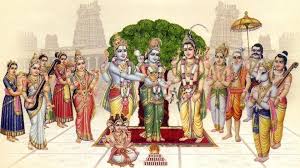
Thiru Kalyanam, also known as the Divine Wedding Ceremony, is a grand and spiritually significant ritual that reenacts the celestial marriage of Lord Vishnu (in his various forms like Sri Rama or Lord Venkateswara) with Goddess Lakshmi, Sita Devi, or Padmavati Devi, depending on the occasion and temple tradition. Celebrated with deep devotion and joy, this puja symbolizes the union of divine masculine and feminine energies, representing harmony, prosperity, and cosmic balance.
Significance of Thiru Kalyanam:
The Thiru Kalyanam ceremony is not merely a symbolic event—it represents the spiritual union of the individual soul (Jivatma) with the Supreme (Paramatma). Devotees who witness or perform this sacred wedding are believed to receive blessings for marital bliss, fertility, harmony, and life-long happiness. The divine couple’s union also marks auspiciousness in the cosmos, ensuring peace and abundance.
Ritual Procedure:
- Alankaram (Decoration): Beautiful idols or images of the divine couple are decorated with flowers, ornaments, and traditional attire.
- Kalyana Mandapam Setup: A ceremonial wedding altar (mandapam) is prepared with sacred items such as mangalsutra (holy thread), turmeric, kumkum, coconuts, betel leaves, and fruits.
- Invocation and Vedic Chanting: Priests chant Vedic mantras and Kalyana Suktams, invoking blessings from all deities, especially from Brahma, who is said to officiate the wedding.
- Divine Wedding Ritual: Rituals such as Kanyadanam, Mangalyadharanam (tying the sacred thread), and exchange of garlands are performed symbolically.
- Aarti and Bhajans: The ceremony concludes with Aarti, devotional singing, and distribution of prasadam.
Conclusion:
Participating in or witnessing a Thiru Kalyanam puja brings immense spiritual merit (punya) and joy. It’s a celebration of divine love, devotion, and the eternal bond between the divine and the devotee.

